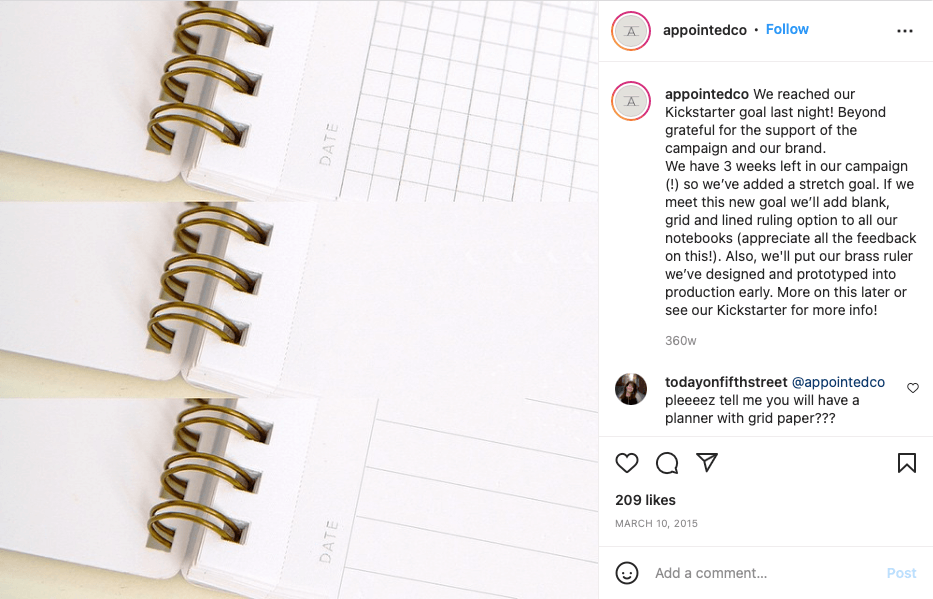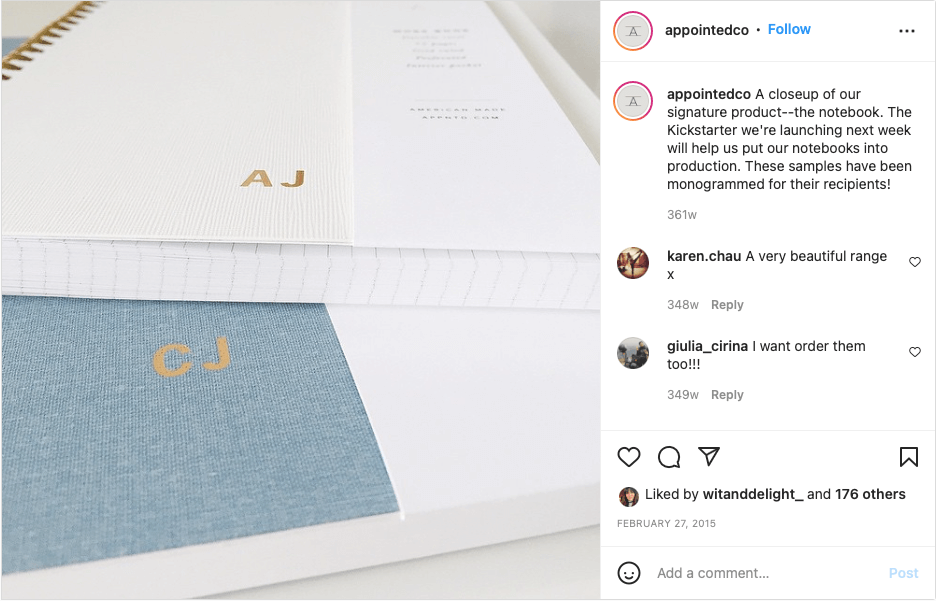In 2014, I began bringing to life an idea for a product and brand that did not yet exist in the market—elevated, everyday, and American-made paper goods to inspire productivity and creativity.
I spent nearly a year fleshing out this idea, prototyping, designing, researching manufacturers, and writing a business plan. It was immediately clear that launching this type of product-based company required capital. It was always my intention and hope to gradually build a company that would be a leader in our category, and that required a plan, goals, an outline for growth, and funding to make it all possible.
After a considerable amount of research, I launched a Kickstarter campaign in March 2015. My goal was to raise $25,000 in 30 days—and I ended up reaching it in seven. In fact, by the end of the campaign, I had raised more than $50,000, which provided the seed funding I needed to start my company, Appointed.
Since then, I often get questions from other small businesses on how to create a successful Kickstarter campaign, or even why to use the platform in the first place. Here’s my advice.
Why Crowdfunding
I had considered all the routes to raise capital—including debt, investing personally, and raising a seed round. I purposefully chose the Kickstarter route because I wanted to also gauge initial proof of concept. If the product didn’t resonate as a Kickstarter campaign, it would have been a sign that perhaps I needed to refine the concept and product.
In addition to social proof, there were many additional benefits to crowdfunding, including:
- Crowdfunding is generally more efficient and far less risky compared to traditional fundraising from investors.
- Launching a campaign allowed us to gain early and loyal customers, many of whom continue to support us to this day.
- It allowed us to build early momentum. When I officially launched the brand shortly after the campaign, our established social proof helped us secure media coverage before our first sale.
Kickstarter isn’t the only option, though, and since my campaign in 2015, many more crowdfunding options have entered the market, including:
- For products: Indiegogo
- For artists and creators: Patreon
- For personal fundraising: GoFundMe
- For equity crowdfunding: CircleUp
5 Tips for Launching a Successful Campaign
No matter which platform you choose, here are my recommendations for setting your crowdfunding campaign up for success.
1. Set a Realistic Goal
Set a realistic and achievable goal based on the dollar amount you actually need. If you exceed your goal, that’s great, but the point is to cover your costs, not reach the highest amount possible. According to Kickstarter, most of the successfully funded projects have a goal of less than $10,000.
I determined I needed an estimated $25,000 to launch the company to fund the following:
- Placing the first run of our signature product, The Notebook, into production, which included purchasing materials, printing, and equipment
- Creating a website (which I designed and hired a freelance developer to build)
- Developing a curated collection of desktop paper products to accompany The Notebook
You can always have a stretch goal if you hit your initial target, just make sure you make it clear what else you’ll offer backers if you hit that goal, too.

2. Research
Before I launched my campaign, I spent 18 months researching what I needed to do to get the company off the ground. And I’d do it again. Being as informed as possible will only help build your campaign, so spend more time than you think you need researching presentation techniques, backer rewards, marketing tactics, and funding statistics, especially as they relate to your specific product type. Fortunately, there are a plethora of resources out there. Kickstarter has detailed resources for creators on its website detailing on how to launch and promote your campaigns, with specific advice for different industries—games, art, design, technology, publishing, and more.
3. Seed Your Campaign
The first few days of a campaign are critical for building momentum. So, reach out to your friends, families, and contacts before you launch, letting them know about the campaign and asking for their support once it's live. I raised $25K in the first week, and most of these initial backers were contacts, friends, and family. As the preliminary backers began to share with their respective networks, we saw the momentum grow daily, which helped us reach our initial goal so quickly.
In addition to directly reaching out to my network, I used every social platform that was available to spread the word about the brand before, during, and after the campaign. Use these tools to tease your product and get people excited about what you’re creating.

4. Think Like a PR Pro
Prior to founding Appointed, I worked in public relations. I put those previous skills to work and reached out to every writer and editor I knew in the hopes of getting the product and Kickstarter campaign featured in stories in the media. But even non-PR pros can take this approach.
Start by compiling an extensive list of relevant outlets and writers and editors who might take interest in the product and the Kickstarter campaign. Even bloggers or podcasters with small but engaged audiences can get you in front of the right people. Then, think about what makes your product unique. What is special or newsworthy about your story? Finally, reach out over email or social media. Be as personal as possible—show them that you have a deep understanding of what they typically cover and pitch them a story that aligns.
5. Have a Plan Post-Kickstarter
While the campaign took a lot of effort, the hard work began once it ended. I was working against a deadline to deliver the rewards to each of the backers while trying to maintain the momentum of the audience I’d built. To ensure you’re set up for success post-campaign:
- Assume your campaign will be successful. Have a very detailed plan and timeline on manufacturing your product and add a buffer to that timeline in case of delays.
- Determine packaging and shipping costs before the campaign and build these expenses into the budget of funds needed.
- Communicate reward delivery and shipping timelines with your supporters. This not only keeps them in the loop about what’s happening, it also continues to build excitement.
I launched a campaign for a single product, but my goal was to build a brand. The Kickstarter campaign allowed me to raise capital, but it was the additional benefits—gaining credibility and establishing momentum—that truly were invaluable.
Six years later, I’m proud that Appointed offers a full suite of desktop and paper goods, supports an ever-growing team of talented people, and has a flagship store in Washington, DC with The Notebook Bar that allows customers to design custom products.
And it all began with a dream, a notebook, and our backers.
Try Buffer for free
190,000+ creators, small businesses, and marketers use Buffer to grow their audiences every month.




